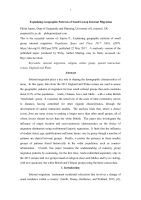Explaining geographic patterns of small group internal migration
Author(s)
Publication Name
Publication Date
Abstract
Internal migration plays a key role in shaping the demographic characteristics of areas. In this paper, data from the 2011 England and Wales census are used to assess the geographic patterns of migration for 4 small cultural groups that each constitute about 0.5% of the population—Arabs, Chinese, Jews, and Sikhs—with a White British “benchmark” group. It examines the sensitivity of the scale of intercommunity moves to distance, having controlled for other migrant characteristics, through the development of spatial interaction models. The analysis finds that, where a choice exists, Jews are more averse to making a longer move than other small groups, all of whom favour shorter moves than the White British. The paper also investigates the influence of origin location and socioeconomic characteristics on the choice of migration destination using multinomial logistic regression. It finds that the influence of student status, age, qualifications, and home tenure vary by group though a number of patterns are shared between groups. Finally, it probes the presence in these smaller groups of patterns found historically in the wider population, such as counter‐urbanisation. Overall, this paper broadens the understanding of minority group migration patterns by examining, for the first time, Arabs (identified separately only in the 2011 census) and 2 groups based on religion (Jews and Sikhs) and by revisiting, with new questions, the White British and Chinese groups using the latest census data.
Topics
Demography Main Topic: Demography and Migration Jewish Neighbourhoods Comparisons with other communities Censuses
Genre
Geographic Coverage
Copyright Info
Accepted version courtesy of author
Original Language
Volume/Issue
23(8)
DOI
Link
Link to article (paywalled), Explaining geographic patterns of small group internal migration
Bibliographic Information
Explaining geographic patterns of small group internal migration. 2017: https://archive.jpr.org.uk/10.1002/psp.2078




